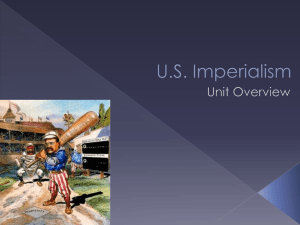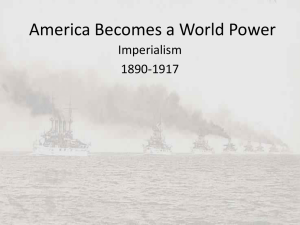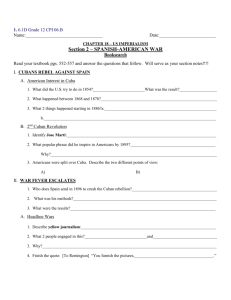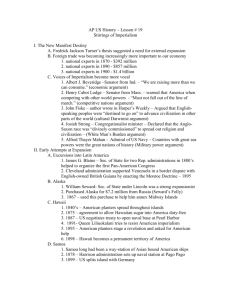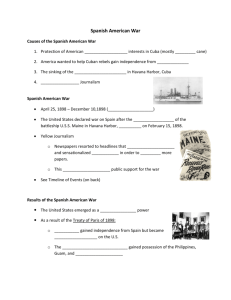Chapter 10 America Claims an Empire Notes
advertisement
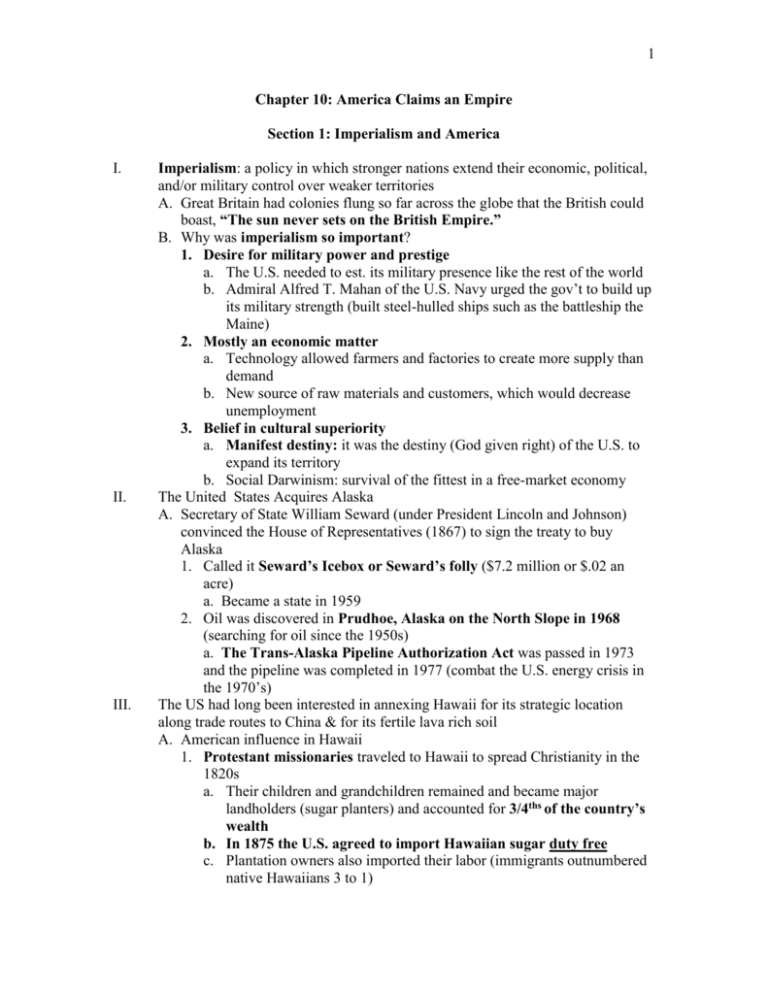
1 Chapter 10: America Claims an Empire Section 1: Imperialism and America I. II. III. Imperialism: a policy in which stronger nations extend their economic, political, and/or military control over weaker territories A. Great Britain had colonies flung so far across the globe that the British could boast, “The sun never sets on the British Empire.” B. Why was imperialism so important? 1. Desire for military power and prestige a. The U.S. needed to est. its military presence like the rest of the world b. Admiral Alfred T. Mahan of the U.S. Navy urged the gov’t to build up its military strength (built steel-hulled ships such as the battleship the Maine) 2. Mostly an economic matter a. Technology allowed farmers and factories to create more supply than demand b. New source of raw materials and customers, which would decrease unemployment 3. Belief in cultural superiority a. Manifest destiny: it was the destiny (God given right) of the U.S. to expand its territory b. Social Darwinism: survival of the fittest in a free-market economy The United States Acquires Alaska A. Secretary of State William Seward (under President Lincoln and Johnson) convinced the House of Representatives (1867) to sign the treaty to buy Alaska 1. Called it Seward’s Icebox or Seward’s folly ($7.2 million or $.02 an acre) a. Became a state in 1959 2. Oil was discovered in Prudhoe, Alaska on the North Slope in 1968 (searching for oil since the 1950s) a. The Trans-Alaska Pipeline Authorization Act was passed in 1973 and the pipeline was completed in 1977 (combat the U.S. energy crisis in the 1970’s) The US had long been interested in annexing Hawaii for its strategic location along trade routes to China & for its fertile lava rich soil A. American influence in Hawaii 1. Protestant missionaries traveled to Hawaii to spread Christianity in the 1820s a. Their children and grandchildren remained and became major landholders (sugar planters) and accounted for 3/4ths of the country’s wealth b. In 1875 the U.S. agreed to import Hawaiian sugar duty free c. Plantation owners also imported their labor (immigrants outnumbered native Hawaiians 3 to 1) 2 B. Americans formed Hawaiian League (1886) which wanted to overthrow the monarchy and persuade the U.S. to annex Hawaii 1. Republican President Benjamin Harrison (pro-business) passed the McKinley Tariff Act of 1890, which raised tariffs and eliminated the duty-free status of Hawaiian sugar a. The Hawaiian League (planters) wanted Hawaii annexed in order to eliminate the duty they had to pay b. Forced king (Kalakaua) to sign constitution that made the monarch a figurehead and limited the right of native Hawaiians to hold office in their own country (only wealthy landowners could vote) c. Convinced king to grant rights to Pearl Harbor for US naval base (1887) C. Queen Liliukalani succeeded her brother as ruler in 1891 1. Pledged to regain Hawaii for Hawaiians a. She announced her plans to publish a new constitution 2. Business groups formed the Committee of Safety with the encouragement of U.S. Ambassador to Hawaii John L. Stevens a. Sanford Dole became the President of Hawaii in 1893 b. Established their own gov’t and declared the end of the monarchy c. Forced the queen to resign from her position 3. President Grover Cleveland (Democrat) sent a new U.S. Ambassador and demanded that the Queen be returned to her throne (Democrats in Congress were also appalled) a. Dole refused to obey the order and included the following in a letter to President Cleveland: “We do not recognize the right of the President of the United States to interfere in our domestic affairs. Such right could be conferred upon him by the act of this Government, and by that alone, or it could be acquired by conquest.” b. Dole declared Hawaii as an independent Republic c. Cleveland’s successor, William McKinley (Republican) negotiated a treaty with Dole 4. Hawaii was not a U.S. territory until 1898 (became a state in 1959 with Alaska) Section 2: The Spanish-American War I. Cuba provided a testing ground for US imperialism and the Spanish were too close for comfort A. Most Americans assumed that Spanish Florida would become a part of the U.S. 1. In 1819 Spain ceded Florida to the U.S. in the Adams-Onis Treaty/The Florida Treaty and gave up its claims to the Oregon Territory a. The U.S. did not rid itself of Spanish colonial clams until 1821 when The Adams-Onis Treaty entered into force 3 B. C. II. A. B. b. The purchase was part of a deal in which the U.S. would pay the $5 million owed by Spain to its own citizens already living in Florida. (1845 became the 27th state) Cubans had constantly been rebelling against Spanish rule (last of the Spanish colonies) 1. The U.S. had been interested in the Spanish colony of Cuba before President Monroe warned outside powers not to interfere in the Western Hemisphere in what became known as the Monroe Doctrine (1823) a. Don’t mess with the Western Hemisphere and the U.S. will not get involved in European affairs or the affairs of existing colonies in the Western Hemisphere 2. In 1886 the Cuban people forced Spain to abolish slavery a. U.S. now invested millions in sugar cane plantations Jose Marti, a Cuban poet and journalist, left New York (in exile) and launched another revolution in 1895 (killed while fighting Spanish soldiers) 1. Focused on guerrilla warfare and target U.S. investments a. He hoped the U.S. would enter the war against Spain to protect investments b. Some U.S. investors wanted to support Spain in order to maintain their business deals while other Americans were reminded of the Revolutionary War 2. Spain sent General Valeriano Weyler (The Butcher) to put down uprisings a. Concentration camps housed 300,000 Cubans (like Hitler) War Fever Escalates Yellow Journalism (exaggerated account(s) of events) engulfed America 1. Hearst in charge of the New York Journal (sent Remington) a. Frederic Remington sent to Cuba to draw pictures showing Spanish cruelty b. He had nothing to draw and his boss said “You furnish the pictures and I’ll furnish the war.” 2. Pulitzer in charge of the New York World (sent Creelman) a. James Creelman exaggerated the so-called Spanish atrocities against the Cubans The De Lome letter and the Maine 1. A Cuban rebel intercepted a letter written by Spain’s Minister to the U.S. (Enrique Dupuy de Lome) a. McKinley was described as “weak” and “a bidder for the admiration of the crowd.” b. The New York Journal published the private letter Feb 9, 1898 2. In 1898 the battle ship the Maine was sent to Cuba to protect US lives and property a. The ship blew up in Havana Harbor on Feb 15, 1898 (260 men were killed) b. Hearst offered $50,000 for the capture of those who set fire to the Maine (Yellow Journalism at its worst) 4 III. A. B. C. D. c. After the war ended, further investigation(s) of the explosion reveal that a coal bin fire may have caused the explosion 3. On April 20, 1898 Congress voted to use military power to help Cuba attain its independence a. Teller Amendment (1898): stated the US claimed no control over Cuba once they won their independence War with Spain Erupts (April 20, 1898 Congress voted to use military power to help Cuba) First battle of Spanish-American War took place in Spanish held Philippines Islands 1. Dewey’s fleet easily crushed the Spanish ships guarding the Philippine city of Manila (May 1, 1898) 2. Dewey and rebel Filipinos helped US soldiers capture Manila & Spanish forces surrendered (Surrendered August 14, 1898) a. Emilio Aguinaldo, leader of the Filipino rebels, was told he would be the President of the Philippines if he helped us defeat the Spanish. Preparation of U.S. forces 1. About 128,000 Americans volunteered to fight, but only about 28,000 soldiers actually fought a. Volunteers raced to enlist and were trained and equipped overnight b. Provided wool uniforms, outdated guns, and canned corn beef that exploded in the heat c. Most of the generals were Civil War veterans that lacked motivation 2. 5400 Americans died a. Only 400 of the deaths occurred in battle and the rest were from disease Major Battles in Cuba 1. Teddy Roosevelt resigned as Assistant Secretary of the Navy in order to lead the cavalry in Cuba called the Rough Riders a. The Rough Riders charged up Kettle Hill (including two African American regimes) clearing the way for an infantry attack on San Juan Hill (U.S. could point their guns down on Spanish troops in Santiago) b. Spanish were already pinned down in the harbor of Santiago de Cuba based on the efforts of the U.S. Navy (July 1 – July 17, 1898) 2. After the great victory in Cuba, the U.S. invaded Puerto Rico on July 25 Treaty of Paris 1. August 12, 1898 Spain signed an armistice and on December 10, 1898 the U.S. and Spain agreed on a treaty in Paris a. Spain freed Cuba, Guam and Puerto Rico were ceded to America, and Spain sold the Philippines to the U.S. for $20 million 2. President McKinley said he prayed for guidance and stated America needs…”to educate the Filipinos, and uplift and Christianize them.” a. Most of the Filipinos were already Christians 3. Some prominent Americans believed we were violating the U.S. Declaration of Independence a. Booker T. Washington believed the U.S. needed to deal with its own race-related issues at home before worrying about the Philippines 5 b. Labor leader Samuel Gompers worried about more immigrants taking jobs 4. February 6, 1899 the Senate approved the Treaty of Paris and annexed the Philippines Section 3: Acquiring New Lands I. Ruling Puerto Rico A. US policy in Puerto Rico 1. General Nelson A. Miles and the military controlled Puerto Rico a. “…bestow upon you (Puerto Ricans) the immunities and blessings of the liberal institutions of our (United States) government.” B. Puerto Rico was much too important strategically and for protecting a future project called the Panama Canal 1. Foraker Act-1900 (same as Philippines Gov’t Act): called for governor & upper house to be appointed by the US, and lower house to be elected by Puerto Ricans. 2. Jones Act of 1917 (same as Jones Act of 1916): made Puerto Ricans American citizens and gave them the right to elect both houses of their legislature a. Supreme Court ruled the Constitution doesn’t automatically apply to people in acquired territories b. 1952 became a self-governing commonwealth of the US (citizenship and trade remains) II. Cuba and the United States A. Teller Amendment (1898): stated the US claimed no control over Cuba once they won their independence 1. In an effort to restore order quickly in Cuba and Puerto Rico, President McKinley set up military governments to rule the islands a. Jose Marti believed one imperialistic country (United States) would simply replace the other (Spain) b. Cubans who protested U.S. policy were imprisoned or exiled by the U.S. 2. The American military provided food and clothing for many Cubans, helped farmers, and helped battle disease a. Charles Finlay theorized that reduction of mosquitoes would stop yellow fever B. Platt Amendment (ratified in 1903): U.S. would pull American troops out if the following was added to Cuba’s Constitution 1. Limited Cuba’s freedom to make treaties with other countries 2. U.S. could intervene in Cuban affairs as it saw necessary (ended 1934) 3. Cuba couldn’t acquire more debt than it can repay 4. Required Cuba to sell or lease land to the U.S. for naval and/or fueling station (Guantanamo Bay) a. Made Cuba an American protectorate: U.S. will protect Cuba from other nations & reserved the right to intervene in Cuban affairs 6 b. 1934 U.S. no longer intervened in Cuba’s affairs C. Massive investments by American businesses in Cuba, was the driving force for the U.S. maintaining a strong political presence in Cuba III. Filipinos Rebel A. Emilio Aguinaldo and many rebels starting fighting against the imperialistic American forces in 1899 1. When Aguinaldo used guerilla warfare tactics the U.S. treated the Filipinos as bad as the Spanish 2. Many of the 70,000 U.S. troops sent to the Philippines were African American a. The black troops questioned why they were sent to spread racial prejudice (whites looked at the Filipinos as inferior) b. The war lasted almost three years, 20,000 Filipino rebels died, 4,000 Americans were killed, and the war cost $400 million B. The Philippines gov’t would be similar to Puerto Rico’s 1. Philippines Government Act (same as the Foraker Act of 1900) a. Philippines would be ruled by a governor and a two-house legislature (William Howard Taft was first governor) b. US would appoint a governor and the legislature’s upper house c. After peace was restored, Filipino voters would elect lower house 2. Jones Act of 1916 (same as the Jones Act of 1917) a. Gave Filipinos right to elect both houses of their legislature once Congress declared that “a stable gov’t” had been established (became an independent republic in 1946) IV. Foreign Influence in China A. In 1843 China officially opened five ports to trading ships from the US and Europe 1. America looked at the Philippines as a gateway to the rest of Asia (China) a. Markets for U.S. products and investors (railroad construction) B. 1853 Commodore Matthew Perry of the US sailed a squadron blackhulled warships into Tokyo Bay b/c Japan needed to understand America’s power 1. Perry’s warships and industrial wonders forced the Japanese to yield to Western demands for trade 2. Japan started to built up its military and industries C. Japan attacked China in 1894 and defeated China in 1895 1. Japan’s 1894 invasion of China marked Japan’s emergence as an imperial power 2. European powers quickly took advantage of China’s weakened position a. Developed Spheres of Influence: ports or regions where a particular country would have exclusive rights over trade, mines, & railroads D. US worried they would be eliminated out of trade with China 1. John Hay created an Open Door Policy (1899): called for all nations to have equal access to trade and investment in China a. Keep all ports in spheres open to all nations, especially the U.S. 7 b. Allow Chinese officials to collect tariffs and duties c. Guarantee equal railroad, harbor, and tariff rates in their spheres to all nations trading in China E. Chinese rebel 1. Fists of Righteous Harmony (Boxers b/c they practiced martial arts): rebellion that wanted to drive the “foreign devils” out of the country a. The Boxer Rebellion started and ended in 1900 b. Attacked foreigners as well as Chinese that converted to Christianity 2. John Hay feared that Japan and other nations would use the Boxer Rebellion as an excuse to seize more Chinese territory a. Second Open Door notes: remind foreign powers of open trade in China and stated the U.S. would, “Safeguard for the world the principle of equal and impartial trade with all parts of the Chinese Empire.” Section 4: America as a World Power I. Teddy Roosevelt and the World A. Japan and Russia were rivals for Chinese territories (Korea & Manchuria) 1. Russo-Japanese War (1904): Japanese troops attacked Russian forces and were winning (destroyed Russian Pacific fleet 2. Japanese started running out of money, so they approached TR to mediate peace negotiations (TR won the Nobel Peace Prize in 1906) a. Japan wins = might grow to strong b. Russia wins = might cut of US trade with Manchuria B. Worried that the Japanese might try to expand in the Pacific, the U.S. flexes their military muscles 1. The Great White Fleet sailed into Yokohama Japan (The Pacific is as much our home waters as the Atlantic) II. The Panama Canal was built to shorten the travel time between the Atlantic Ocean (Caribbean Sea on this side) and Pacific Ocean A. Early attempts to build a canal 1. Clayton-Bulwer treaty (1850): proposed an equal partnership between US and Great Britain to run and build a Central American canal (never occurred) 2. French company (1880): actually worked on a canal but abandoned the effort (disease & cost too much) a. Sold the French route to the U.S. for $40 million 3. Hay-Pauncefote Treaty (1901): Britain agreed that the US could build the canal by itself and have exclusive management & policing of it 4. Hay-Herran treaty (1903): in return for a 99 year lease of land across the Isthmus, the US agreed to pay Columbia $10 million & a yearly rental of $250,000 a. Columbia’s Senate decided to hold out for more money B. Panamanian leaders who wanted the canal built began plotting a revolution against the Colombian gov’t 8 1. Philippe Buanau-Varilla (chief engineer in French attempt to build canal) met with Roosevelt to gain support for revolution a. U.S. gunboat Nashville, along with almost a dozen U.S. warships, arrived in Panama & the rebellion against Columbia occurred (Nov 3, 1903 Panama declared its independence) 2. Hay-Bunau-Varilla Treaty: gave the US complete & unending sovereignty over a 10-mile-wide Canal Zone (pay Panama $10 million and a yearly rental fee of $250,000) a. No Panamanians signed the treaty 3. Annoyed by the media, TR said, “I took the Canal Zone and let Congress debate.” a. In 1921 Congress agreed to pay Columbia $25 million in compensation C. Work on the Panama Canal started in 1904 and ended in 1914 1. It cost America $380 million, 5,600 out of 43,400 workers died from disease or accidents a. On August 15, 1914 the canal opened for business III. President Monroe and the Monroe Doctrine A. In the Monroe Doctrine (1823), the U.S. warned that it would not allow any interference by other countries in Latin America 1. Used to protect U.S. interests in Latin America 2. A great deal of U.S. capital in Latin America was in the form of highinterest bank loans (protect U.S. investments) 3. Great Britain, Germany, and Italy attacked Venezuelan ships because the country did not pay back its loans a. Roosevelt convinced them to settle the problem by arbitration b. U.S. will enforce the Monroe Doctrine B. The Roosevelt Corollary to the Monroe Doctrine (intimidation) 1. TR reminded Europe of President James Monroe’s Monroe Doctrine a. TR warned disorder in Latin America might “force the U.S…to the exercise of an international police power.” (the U.S. will use force) 2. U.S. would protect the Dominican Republic territory from other countries if they let the U.S. collect all Dominican custom duties & turn half over to foreign creditors C. President William Taft, Roosevelt’s successor, believed in Dollar Diplomacy 1. U.S. would give Latin American countries protection in exchange for more U.S. economic influence in their countries 2. Increasing U.S. economic power would reduce the chances of European intervention 3. American bankers loaned money to the nearly bankrupt nation of Nicaragua a. The U.S. bankers started to control the infrastructure of Nicaragua and the citizens rebelled b. Taft crushed revolts in Nicaragua to protect U.S. investments (U.S. money and Marines were sent to help the gov’t of Diaz) 9 IV. D. President Woodrow Wilson, Taft’s successor believed in missionary diplomacy: pressure and only recognize gov’ts that that promote and utilize democratic gov’ts 1. Wilson’s philosophy would be tested during the Mexican Revolution Wilson’s Challenges in the Mexican Revolution A. Mexico’s president Porfirio Diaz helped U.S. investors take control of Mexico’s economy 1. Diaz and wealthy landowners controlled Mexico’s oil, mines, railroads, ranches, and profits a. U.S. owned ¾ of Mexican mining B. Angry peasants and struggling urban workers rebelled 1. Francisco Madero (1911) and angry citizens defeated Diaz and his troops a. Diaz tried to rig the 1910 election b. Diaz went into exile in Paris & Madero won the presidency 2. People were not happy with Madero’s plan to establish a democratic gov’t (could not please all the various interested in and out of Mexico) a. US ambassador Henry Wilson had a meeting to discuss the overthrow of Madero (wanted to protect US investments) C. General Victoriano Huerta seized control of the gov’t, once Madero was jailed 1. Madero was killed by Huerta’s soldiers a. Huerta was backed by wealthy landowners and investors 2. President Wilson was outraged a. Authorized arms sails to revolutionaries trying to overthrow Huerta b. Called Huerta’s regime a “government of butchers.” 3. On April 9, 1914 Huerta’s soldiers arrested several crew members from the USS Dolphin that went ashore for supplies a. They were released unharmed, but Wilson used this as an excuse to intervene in the revolution b. President Wilson learned about German arms heading to Huerta (U.S. marines stopped the shipment) 4. Mediators from other countries stepped in and urged Huerta to resign in 1914 and American soldiers to withdraw a. America and Mexico rejected the plan b. Huerta regime collapsed anyway D. Venustiano Carranza, a nationalist leader, assumed the presidency in 1915 1. US recognized his gov’t, because he would respect foreign lives & property E. Pancho Villa opposed Carranza’a gov’t and felt betrayed by the U.S. (Villa often worked with the U.S.) 1. Villa (1916) took Americans of a train that was heading to the Northern mines of Mexico and assassinated them 2. Villa (1916) also raided Columbus, New Mexico killing 17 Americans, hoping the US would intervene & cause problems for Carranza 3. Wilson sent 15,000 U.S. troops into Mexico to get Villa dead or alive (General John J. Pershing led forces) 10 a. Mexicans resented America’s invasion of their land b. In June 1916 U.S. troops and Carranza’s troops clashed resulting in deaths on both sides F. U.S. did not want an all out war with Carranza because WW I was building in Europe 1. U.S. didn’t want to fight on two fronts (Europe and Mexico) 2. US troops pulled out to avoid a war, and in 1920 a moderate named Alvaro Obregon came to power V. The U.S. accomplished many of its foreign policy goals in the 20th century A. The following goals were accomplished by the U.S.: 1. Expanded access to foreign markets to ensure the domestic growth 2. Built a modern Navy to protect U.S. interests abroad 3. U.S. used its police power to dominate events in Latin America


